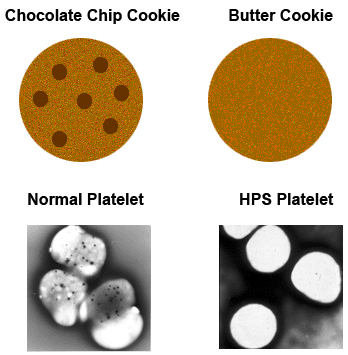Diagnosing HPS
Although 11 of the genes causing HPS have been identified, it is believed that additional genes may remain undiscovered. The method for a differential diagnosis remains testing for the platelet defect if gene testing has not been done. Once an HPS diagnosis is made, genetic testing is helpful because knowing the gene type can help to predict expected symptoms.
Platelets are involved in one of the mechanisms that exist within the body to counteract bleeding. Platelets are made in the bone marrow and circulate in the bloodstream in large quantities. They act directly to plug small leaks in vessels by clumping (aggregating) and obstructing flow, and indirectly by releasing chemical substances that trigger a chain of events that culminates in a clot.
These chemical substances (ADP, serotonin, calcium, ATP, phosphate) are normally stored in platelet dense granules. These dense granules are little sacs, or compartments, that are embedded in the outside membrane of the platelet. Filled with the stored chemicals they look like “chips” and the platelets appear to look like a “chocolate chip cookie” under an electron microscope. These chemical substances are destined to be released to assist in clotting. There are normally three to eight dense granules on a platelet. In Hermansky-Pudlak Syndrome, these dense granules are usually missing. No chemical substances are stored, therefore none are released. The platelets appear to look like a “butter cookie” instead of a “chocolate chip cookie” under an electron microscope.

Standard laboratory blood test results are not abnormal in HPS. Prothrombin time (PT), partial thromboplastin time (PTT), and platelet counts are all normal in HPS. Bleeding times can be normal though they are often prolonged. The clinical result of the defect in HPS can be seen in a bleeding tendency that varies from quite mild and hardly noticeable to life threatening. There is a possibility some people with HPS that encounter severe bleeding problems, might also have a decrease in platelet von Willebrand factor activity, another blood component responsible for normal clotting.
Viewing prepared platelets under the electron microscope is a definitive diagnostic test for HPS at this time; however, commercial genetic testing is available in limited cases. Contact the HPS Network (info@hpsnetwork.org) if more information or assistance is needed. (800) 789-9477 or (516) 922-4022


